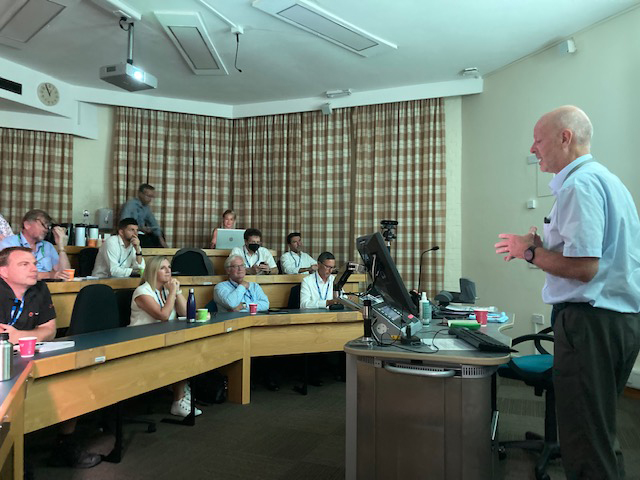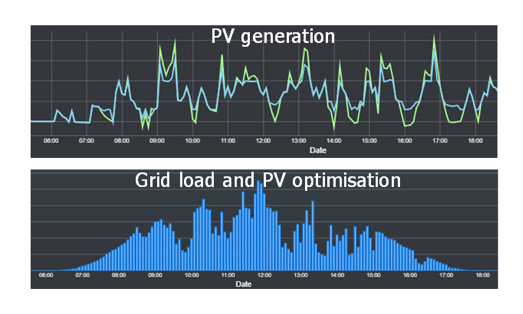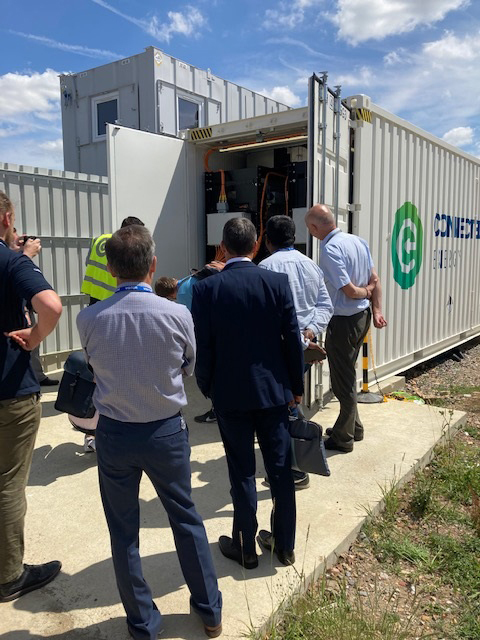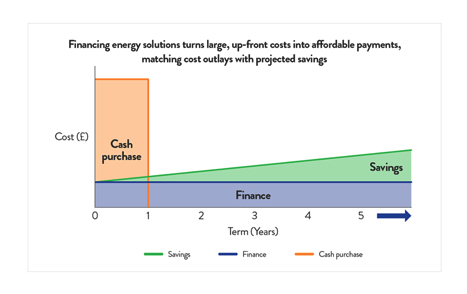
Almost exactly a week before temperatures reached 40˚ in many parts of the country, a group of executives from local councils, local government and the private sector, including Oxfordshire, Westminster, Nottingham, Milton Keynes and TfL visited the Cranfield University campus where Connected Energy has installed three second life battery storage systems.
The three battery energy storage system (BESS) units that use Renault Kangoo electric vehicle batteries, were supplied by Connected Energy, the British business with its HQ in Newcastle.
The BESS at Cranfield allows the site to balance its energy across its own private network, with the ability to charge from the soon to be enlarged solar farm. The battery also manages the increase in electrical demand from the new air source heat pump recently installed on the district heating network, which helps to reduce reliance on the gas-combined heat and power system (CHP).
Many organisations are keen to see how the BESS integrates with the other technologies on site and understand what aspects would work for them. This was the second behind the scenes tour of Cranfield’s recently installed system, and further tours will be offered soon.

The beauty of a BESS
It’s a common misconception that battery energy storage should only be paired with solar or wind generation. A standalone battery energy storage unit can deliver cost and carbon savings in a variety of ways of interest to councils and housing associations.
A unit can be used to selectively store energy from the national grid so that a site always remains within its green tariff. It can also be used by businesses to make additional revenue by supporting imbalances in the grid when it’s needed, something that the National Grid will pay for as a service. It can also be used to support a site against energy fluctuations, protecting it from damaging electricity brownouts or blackouts.
A unit can also save a substantial amount of money and headaches at sites that are grid constrained. The term ‘grid constrained’ is going to become increasingly familiar to council and housing associations as they look to add EV charging or air heat source pumps and discover their site doesn’t have the electricity capacity to cope.
An extra 100 kilowatts of connection could cost £1,000 or £100,000 depending on the site and the constraints in the area, and for some it will simply be impossible to increase grid connectivity. This was the case at Cranfield. Here the site has overcome its connectivity issues with the installation of its BESS and taken full advantage of the other services a BESS can deliver.
Of the three battery storage units on the campus, one takes excess solar generation at the weekends and delivers this back to the campus on Monday, and two others connect the battery storage system directly into the site’s electricity transformers.
Guests on the tour were able to ask Gareth Ellis, Cranfield Energy & Environment Manager, directs questions about how the system works and see information as it comes through the BESS initiative dashboard. The Connected Energy Management Platform (CEMP) provides information in an easy to understand format, and serves as a data ‘heart’ of the system.

The best of the BESS
What is significant about the energy storage units at Cranfield and will be particularly appealing to councils with challenging Climate Strategy and Action Plan targets, is that they are made from used car batteries. Each contains 24 used Renault Kangoo vehicle batteries.
While operationally identical to units made from new batteries, these second life storage units provide a positive carbon benefit of 450tCO2e for every 1MWh installed compared with a first life energy storage unit. This kind of carbon saving is hard to achieve in any other way. A further attraction of the second life option is that they bypass supply chain issues.
Top three questions
Not surprisingly there was keen interest in Connected Energy’s storage solution during the tour. The top three questions asked on the day were:
- How does the battery storage system integrate with the solar PV?
- How long can you use the battery system in its second life?
- How do you manage fire risks for the battery system?
Integration with solar PV is easily done as the units are installed. This usually requires an additional transformer and cabling to complete the connection. Although not essential, solar PV is often a welcome additional benefit of a BESS.
A BESS installed today is expected to be operational until 2042. During that time its batteries will need to be switched out a few times, at intervals of around seven years in a second life system, or 10 for new batteries. This process is taken care of automatically as part of the management package, which includes remote monitoring and maintenance.
And in terms of fire risk this is also answered simply. Second life units come with the same fire safety and peace of mind that comes with driving an electric vehicle, as the batteries are intact vehicle batteries. All the R&D and safety embedded in them remains; the batteries operate exactly as if they were in a vehicle, connected and operated through Connected Energy’s advanced battery management systems.
Before the units are installed, a site survey quantifies the location from a safety and security perspective to ensure it complies with all existing legislation. The units themselves are equipped with an array of sensors.
Batteries are monitored individually through the sensors on a real time basis to ensure that both the cells and battery management systems are working as they should. If any anomalies are identified the battery is isolated, powered down and an engineer alerted. Individual batteries can be isolated while the remaining system continues to operate.
Temperature is monitored and maintained by air conditioning units, which have their own back up electricity supply, operated automatically in response to local weather conditions.

storage system at Cranfield University energy centre
The bottom line on BESS
Shortly after the tour at Cranfield took place, the first of the heatwaves in UK and Europe began. Even before weeks of excessive heat, forest fires and drought took their toll, there were no doubts in people’s minds about the need to adopt new technology to address global warming.
The only remaining questions were about funding and finance:
- What finance is available to pay for BESS for local councils?
- When does a BESS pay back energy bill savings?
- What carbon savings will it deliver?
Cranfield’s system was paid for by £5m grant under the Department for Business, Energy and Industrial Strategy’s (BEIS) Public Sector Decarbonisation Scheme (PSDS), managed through Salix. Applicants must be using a fossil-fuelled heating system, which is coming to the end of its useful life, and be planning the installation of heat decarbonisation and energy efficiency measures.
Phase 3 of the Public Sector Decarbonisation Scheme, announced last year, will provide £1.425bn of grant funding over the financial years 2022/2023 to 2024/2025, through multiple application windows.
Applications for grants in England are open, meanwhile information from Salix about previous grant funding is listed below. There are also a range of grants available for different nations and regions, some of which are listed here: Phase 3 Public Sector Decarbonisation Scheme (PSDS) Guidance; Scottish Green Public Sector Estate Decarbonisation Scheme; The Wales Funding programme and Mayor of London Energy Efficiency Fund.
Any organisation with an energy bill of over £100,000 per annum would benefit from a BESS, and bills are in excess of £500,000 a year are not uncommon across large or multi-site estates. While the payback time depends on many factors, as a rule of thumb, an organisation with energy costs as high as these would see a payback within four to five years. Recent price hikes have reduced the payback time dramatically.
Battery as a Service
While councils tend to prefer grant-funded solutions, an option open to any organisation such as a housing association is a financial plan called ‘Battery as a Service.’ This is where the battery storage units are supplied as part of a finance package and paid for over a fixed-term for an agreed amount each month, with a full range of guarantees around capacity, availability and maintenance included.
The total capital cost, installation, warranty, management and maintenance — every possible cost — is calculated and divided by the term, such as seven or 10 years — to agree a monthly fee. The advantage of this is that monthly costs are managed and known, without any capital outlay.

There are no ‘ties’ with energy companies with this arrangement, which mean that frequency response revenue is paid directly, should such an arrangement be in place. On occasions when frequency response is especially high, this could be used to pay more of the monthly fee, a bit like mortgage over-payment. More details about ‘Battery as a Service’ is available from https://c-e-int.com/energy-storage/products-services.
Carbon saving
Inevitably, questions on the tour tended to focus on how much a BESS costs to install, and cash flow benefits. In some respects, carbon savings are a given, but it is worth reiterating the very real carbon reductions that can be achieved through the installation of a BESS.
The best possible carbon savings are achieved through capturing solar PV in the BESS, but there are many other steps that could or should be taken along the way to maximise carbon savings.
Matthew Lumsden, Connected Energy CEO, advises conducting a site and energy audit before buying a BESS: “This is a fantastic piece of equipment which has rightly been described as the true bridge to a clean energy future. To do justice to the opportunities for carbon reduction and energy transformation, which a BESS offers, ideally it should be considered as part of a holistic site and energy audit, to ensure the benefits in addition to reduced energy bills are fully realised. This is something that Connected Energy offers to our customers to ensure that the system will be commercially viable for them.”
Cranfield has been through this review process, as Gareth Ellis explained to those on the tour, and the generosity he and other staff at Cranfield have shown in showcasing their facility will allow others to speed up their own transition to a clean energy system.
To sign up to the next tour at Cranfield please email Nigel.Dent@c-e-int.com with the heading ‘Cranfield Tour.’








